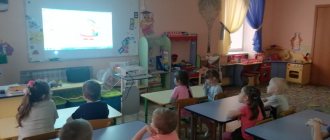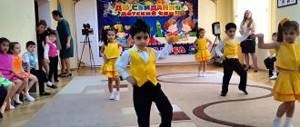What is psychogymnastics
The appearance of the term “psycho-gymnastics” is associated with the name of the Czech psychologist Gana Unova. In the seventies of the twentieth century, Ghana developed a technique based on non-verbal communication, designed to resolve certain psychological problems.
Psychogymnastics is a course of specialized classes that includes various exercises in a playful way, aimed at developing and correcting various aspects of the child’s psyche.
Structure of psycho-gymnastics
The structure of psycho-gymnastics includes a continuous course of active classes and exercises, the completion of which is divided into 4 main stages. Each new stage of development and correction of the child’s not yet formed psyche is described in detail in the table below.
| The structure of psycho-gymnastics for preschool children | Description of each stage of development of the child’s psycho-emotional sphere |
| Stage 1 | The first stage of psychogymnastic development of the personality of a child and an adult is the creation of pantomimic and facial sketches. The main purpose of performing these actions is to independently depict emotional states associated with dissatisfaction or a feeling of deep satisfaction. Preschool children become familiar with the first ways of expressing their mood through gestures, facial expressions, gait, and individual movements. This is the initial stage of understanding your inner world and the ability to express yourself. |
| Stage 2 | The second stage of psycho-gymnastics includes participation in interactive games aimed at modeling the behavior of specific characters. All expressive actions and gestures of the child are aimed at reproducing the character traits of an individual. In most cases, these are kind characters from fairy tales and cartoons who have exclusively positive personal qualities. |
| Stage 3 | At the third stage of psycho-gymnastics, special exercises are used that already have a therapeutic focus. This technique is applied to a specific child whose psyche requires gentle correction. In the process of organizing psycho-gymnastics, sketches and interactive games are used. With the participation of a teacher or child psychologist, certain situations are modeled in which the child develops specific character traits, shows courage, perseverance, politeness, determination, and kindness to the people around him. |
| Stage 4 | The fourth stage of performing psycho-gymnastics exercises is to organize effective psycho-muscular training. The main goal pursued in this case is to eliminate emotional stress, achieve the effect of instilling in the child the desired model of behavior and a certain psycho-emotional state. For this purpose, special exercises, sketches, and reproduction of specific life situations are used. Provided that psycho-gymnastic exercises are successfully carried out, the child acquires a formed behavioral model and shows resistance to the influence of negative environmental factors and stress loads. |
The structure of psycho-gymnastics necessarily includes a set of exercises to develop attention, relieve excess psycho-emotional stress, reduce social distance, and acquire skills for mutual assistance and cooperation. The general course of psycho-gymnastics includes 20 exercises, and its duration is 3 months.
The frequency of meetings between a child and a teacher or child psychologist is 2 sessions per week. The duration of 1 training session depends on the number and type of psychological problems, as well as the tasks set, but on average it ranges from 25 minutes. up to 1 hour 30 minutes
Why do we need psycho-gymnastics?
Psychogymnastics can solve a number of problems related to maintaining the mental health of children. Despite their young age, children, just like adults, face various difficulties. But their life experience is still too small to allow them to overcome the difficulties that arise on their own.
Children need to make contacts and build relationships every day. Moreover, both with their peers and with adults. Much is unclear. Both in others and in yourself.
Psycho-gymnastics helps children find peace of mind, harmony with themselves, with the inner and outer world.
Thanks to psycho-gymnastics, children are able to cope with hyperactivity, reduce feelings of anxiety, get out of a closed state, “open up”, get rid of aggression, and become more self-confident.
One of the most important tasks of psychogymnastics is the recognition of experienced feelings and emotions.
Expressive movements
In the course of evolutionary development, each sensation and feeling of a person has been assigned one or another characteristic “motor” expression—reaction.
Outwardly, this reaction is always accompanied by facial expressions or pantomimes.
Facial expressions
Facial expressions help to recognize a person’s true emotions, feelings and mood without words. For example, a smile indicates a good mood. Vertical folds on the forehead and knitted eyebrows make it clear that a person is angry. The look shows even more emotions.
He can be affectionate, questioning, angry, kind. It’s not for nothing that they say that the eyes are the mirror of the soul. After all, as a rule, it is the eyes that always “tell” the truth. What a person really feels. It is facial expression that plays one of the most important roles in the communication process.
The expression: “Emotions reflected on the face are heard louder than speech” explains the need for the timely development of “live” facial expressions in children. After all, kids are not always able to say what they feel. And it is important for adults to know what their child is going through now.
It is also necessary to teach children to recognize these nonverbal signs in others. After all, this is the basis of any communication.
It has been proven that people with developmental delays are much worse at “reading” and recognizing feelings on the face of another person.
In this regard, parents need to pay increased attention to the development of facial expressions in children.
Gesticulation
Research shows that children with normal development by the age of three can correctly use sign language at an everyday level. They easily show the word “high”, “low”, “small” and others.
This means that close attention should also be paid to the development of gestures.
Pantomime
An important role in the perception of a person’s image is played by his posture and posture. Which together gives pantomime.
By a person’s posture, the position of his body, the tilt of his head, and by the way his posture changes, one can also judge his emotional state and mood.
All of the above are expressive motor skills. Disturbances in its development in children deserve close attention from adults.
The inability to correctly express one’s emotions and incorrect perception of other people’s emotions lead to communication problems.
It becomes difficult for children to build relationships both with peers and with adults.
In addition, such violations may be signals that the child has mental disorders. Timely diagnosis and taking appropriate measures can prevent a child from serious psychological problems in the future.
Psycho-gymnastics is considered a truly effective assistant in working on the development of expressive movements in children.
Emotions
Emotions are an integral part of any person’s personality. Every day and even every minute we all experience certain emotional states.
Some emotions are uplifting and motivating. Others can drive you into depression and lead to serious internal and external conflicts.
In this regard, it is obvious that you need to “make friends” with emotions. Be able to keep them under control.
Children have a particularly difficult time establishing these relationships. This is explained by a lack of life experience and a lack of understanding of one’s own personality.
Psychogymnastics is a faithful assistant in resolving this issue.
Let's try to consider primary emotions and the role of psycho-gymnastics in their understanding.
Interest
The importance of interest in people's lives is difficult to overestimate. After all, absolutely everything begins with interest: from communication between people to career success.
In general, interest is a certain attitude of a person towards an object, depending on its emotional appeal and life significance.
Primary interest in children is unconscious and chaotic. However, over time it may well turn into a need.
The older the child is, the more stable his interests are. Over time, they develop into attachments. The stronger the interest, the longer it remains in the child’s life.
A positive feature of interest is that it can motivate a person to take real action. It represents a kind of internal driving force that helps to overcome emerging difficulties. In study or work.
A popular exercise in understanding the meaning of the emotion “Interest” in psycho-gymnastics is playing “living” pictures.
Children seem to peer into the distance, listen, observe, read. The “frozen” poses of living paintings are complemented by active games with invented objects.
Such sketches are especially effective and necessary for children who have problems concentrating. Disinhibited or developmentally delayed. Useful for defects in emotional expressions. They help you learn to concentrate and maintain a certain focus of attention.
Joy
Recognizing joy is quite simple. Upturned lip corners and wrinkles around the eyes are typical signs of a natural smile. And a smile is the primary manifestation of joy.
Already in infancy, children begin to experience a feeling of joy. It helps establish interpersonal connections. Strengthens social contacts. Increases sensitivity. Increases motivation. Gives confidence. Calms and distracts.
Joy cannot be forced. But you can create situations that can evoke a feeling of joy.
In psycho-gymnastics, “Joy” exercises are performed, as a rule, on the principle of oppositions: suffering - pleasure or struggle - the joy of victory, and others.
Astonishment
One of the shortest and most definite emotions is surprise. For a person to be surprised, something unexpected must happen.
As a rule, the following sequence of emotions occurs depending on their color in a positive or negative direction. Surprise - positive emotions - arousal of interest. Or, for example, surprise - a feeling of shame - fear.
It is believed that surprise is necessary in order to remove the emotional state from the current sensation and give the nervous system the opportunity to adapt to other conditions.
In psycho-gymnastics, sketches are surprisingly expressive and easily repeatable. Characteristic external signs are wide open eyes and an open mouth. Active gestures are encouraged.
Distress
Distress is a negatively colored emotion that characterizes sadness, grief, and suffering. Imitation of minor moods is effective for psychotherapeutic purposes.
One of the exercises in psycho-gymnastics is listening to minor music and then playing the moods that it evokes. This type of therapy teaches children empathy.
To quickly switch the mood of children, immediately after sad music, they are played with cheerful melodies and also asked to depict the evoked emotions.
Understanding and empathy are important elements of effective communication. They need to be developed from early childhood.
Disgust
Initially, a feeling of disgust manifests itself in children only in relation to the unpleasant smell and taste of food. Nausea is the primary symptom of disgust.
With age, the child may experience this feeling in relation to himself, to others, or from others. It will look like disgust.
Disgust has an extremely negative impact on a person’s personality. It contributes to low self-esteem and loss of self-esteem. All this makes me depressed.
There are many cases when this particular emotion brought people, especially teenagers, to critical states. To the point of trying to give up your own life.
In psycho-gymnastics, there are exercises aimed at mitigating the emotion of disgust.
Some works of H.H. Andersen come to the rescue. Where this emotion is described quite well, which helps children learn to play it. This means he will learn to manage it over time.
Anger
A flushed face, furrowed eyebrows, protruding lips, clenched fists and active gesticulation are quite typical characteristics of an angry person. In anger. Furious.
By the age of two, children clearly distinguish the facial expressions of a threat from a smile. However, at first, children tend to confuse the concepts of “strong” and “angry.”
It is known that negative emotions must find a safe outlet. They cannot be accumulated inside. A productive outlet for anger clears the mind and provides clarity of thinking.
Psycho-gymnastics teaches you how to properly throw out negative emotions without harming yourself and others.
Fear
Fear is one of the earliest emotions experienced by a person. It is also worth noting that this emotion is contagious and has a serious impact on the behavior of people both in adulthood and at a very young age.
The first fears arise in babies in relation to strangers and unknown objects.
The next typical fear is the fear of the dark. Psychologists associate its appearance with the development of imagination. It is believed that even in adults, it is in the dark that fantasy plays out most vividly.
Often children cannot distinguish reality from fiction. Why do they feel fear even from book or cartoon characters? For example, the fear of Baba Yaga or Koshchei the Immortal.
With age, the understanding of fears and the fears themselves change. As children grow older, they begin to fear accidents, fear for the lives of their loved ones, and for their own existence.
On the one hand, such experiences protect against committing dangerous stupidities. On the other hand, phobias prevent you from living and enjoying the joys of life to the fullest. They lead to aggressiveness, nervous disorders, sleep disorders, and speech problems.
Psycho-gymnastics helps you learn to vigorously express fear in a playful way. Helps to work through individual situations that cause increased anxiety. Develops psychological resistance to fears.
The most effective studies are those aimed at re-enacting scary situations and children drawing their own fears.
Shame
Psychologists unanimously consider shame one of the most painful social emotions. A child experiencing a feeling of shame constantly experiences a feeling of fear for his behavior and is afraid of public condemnation. Why does one become closed and remain in a state of internal conflict with oneself and with society? Feels dissatisfaction with himself, which leads to the development of complexes.
Excessive shyness and timidity, which interfere with an active social life, are a direct consequence of an unprocessed feeling of shame.
Psycho-gymnastics helps children cope with situations they have already experienced in which they experienced shame. It also teaches how to curb this emotion in the future. Harmonizes the state of mind.
Psycho-gymnastics step by step
There are a lot of mental training exercises; each teacher has his own program, but no matter what it is, it is built according to a certain pattern.
Preparation
This includes those exercises that develop attention, smoothly turning into stress relief in order to reduce the trust distance. Here the necessary mood is created, fears and prohibitions on frank communication are removed. Psychologists have many such ways to relax and trust.
So, when there are several gymnastics participants, they turn for help to the children's game about a gape who does not have time to sit on a chair. Individually, the method of repeating facial expressions one after another in front of a mirror is used.
Introduce your child to joy and interest, surprise and anger, fear and pride through gestures, facial expressions, and gait, and this will help overcome the threshold of initial mistrust.
Attention exercises can concern sounds outside the window, surrounding objects, and touches. The most important thing is to do it with a smile, then the atmosphere will become inviting. Only after a good warm-up do they begin the next stage. By the way, if you decide to start psycho-gymnastics at home with your child, then during the first lessons it is recommended to focus on this part; you should not rush headlong into the pool.
Pantomime
This main part of the lesson is devoted to the problem, which is discussed out loud, opinions are expressed and experiences are made public. If everything is done correctly in advance, then during pantomime creativity begins to flow like a fountain. Whether it's cheating or a quarrel, failure in class or fear of a test, someone will imitate the action, and someone will actively copy.
It's best to switch places.
The purpose of pantomime is to allow one to experience different sensations through imitation and repetition of movements, to hone, at the level of automatism, the ability to hold attention to emerging feelings, compare emotions, change movements depending on sensations and imagination.
Therefore, we tense and relax, doing it sharply and smoothly, often slowly, moving freely and encountering obstacles.
And as a result, you will see that your child has “got into the groove”, skillfully alternating movements, improving his mood and relieving tension. By the way, if you are not ready to discuss a specific situation in your child’s life and are worried that he will not be able to tell you everything confidentially, pick up and play out a similar problem from a fairy tale, why not?! No one has canceled fairytale therapy.
Methods of psycho-gymnastics
Psycho-gymnastics is carried out according to a methodology that includes four main stages (or phases):
- Sketches performed using facial expressions and pantomime.
- Expressing specific character traits and identifying the emotions associated with them.
- Psychotherapy.
- Relieving mental and emotional stress.
At the first stage, children will have to become familiar with specific emotional states. Gestures, facial expressions, pantomimes come to the rescue.
The second phase is aimed at depicting feelings caused by the social environment. As a rule, behavioral models of famous characters with pronounced character traits are played out.
At the third stage, the child’s already established behavioral characteristics are corrected through modeling specific situations.
At the fourth stage, psycho-emotional stress is relieved. Children are encouraged to have a positive mood and are taught desirable character traits and behavior patterns.
Exercises
Examples of typical psychogymnastics exercises.
Blind Dance
The purpose of this exercise is to develop trust between children and relieve muscle tension.
Children are divided into pairs. One child from the pair is blindfolded. He plays the role of the “blind man”. The second baby remains sighted and plays the leading role in the duet.
Children join hands and dance together to melodic light music. The dance lasts about two minutes. Afterwards, the children are asked to switch roles.
If an anxious baby refuses to close his eyes, it is recommended not to insist. Let him dance with his eyes open.
Bunnies and elephants
The game is aimed at increasing self-esteem in children. Gives you the opportunity to feel strong and courageous.
First, the children are asked to get used to the role of little bunnies. Children are asked the question: “How does a bunny behave when it experiences fear?” If they find it difficult to answer, then they should be prompted by pretending to tremble.
Next, a scene plays out in which a dire wolf walks. Little cowardly bunnies scatter around the room. They are hiding. They are shaking.
After this, the children return. They are asked to imagine themselves as big and strong elephants. Play out his stately, calm gait.
Children are told that brave elephants are not afraid even of a tiger. Remain calm in his presence. The presenter plays the role of a tiger, and the children show how elephants behave in such a situation.
After finishing the game, the guys sit in a circle. Each child's feelings in both roles are discussed. It is important to understand which one they liked more and why.
Exercises for psycho-gymnastics in elementary school
"CURIOUS BARABARA"
Exercise to relax the neck muscles.
Curious Varvara looks to the left... looks to the right... And then forward again - Here she will rest a little... The neck is not tense and relaxed!!! And Varvara looks up! Higher than everyone, further and further upward Coming back, Relaxation is pleasant! The neck is not tense and relaxed!!! Now let's look down. The neck muscles are tense! Coming back, Relaxation is nice!!! The neck is not tense and relaxed!!!
"TRAVEL ON THE CLOUD"
I want to invite you on a journey on a cloud. Jump into a white fluffy cloud that looks like a soft mountain of plump pillows. Feel how your legs, back, butt are comfortably located on this large pillow. Now the journey begins. Your cloud slowly rises into the blue sky. Do you feel the wind blowing across your face? Here, high in the sky, everything is calm and quiet. Let your cloud take you now to a place where you will be happy. Try to mentally see this place as accurately as possible. Here you feel completely calm and happy. Something wonderful and magical can happen here... (Pause 30 seconds)
Now you are back on your cloud, and it is taking you back to your place in this class. Get off the cloud and thank it for giving you such a good ride... Now watch how it slowly melts into the air... Stretch, straighten up and be kind, fresh and attentive again.
"BY THE SEA"
Sit comfortably and close your eyes...Take three deep breaths and exhale and find within yourself a point of inner peace - a place in the soul where it is quiet and calm. If you listen carefully, you can hear the waves of the ocean gently rolling onto the shore. Perhaps at first the sound of the ocean is heard somewhere far away, but gradually the sound of water rolling onto the shore becomes louder and louder... Then the wave rolls back... Then it rushes to the shore again and retreats again... The rhythm of the surf sounds smooth and soothing. Let the waves wash away and carry away your worries and everything that stresses you out. And just as the waves smooth the sand on the shore, they can make your mind calm and clear. Imagine that you are sitting on the seashore. The sand surrounding you is completely dry and soft. Look around and you will find that you are all alone on the shore. The sun is setting and colors the sky in gold, red, pink and lilac tones. You feel the warmth of the evening sun with all your skin and, glancing at the water, you see the reflections playing in the waves. Take a deep breath and feel the salty taste of the sea. The sea air is fresh and slightly humid. You hear the seagulls scream, letting the wind carry them far into the sky. At times they float almost motionless, freezing in the oncoming air flow. You now feel completely calm and serene and take advantage of the calm and silence of the sea to ask yourself an important question. Find simple and clear words for your question. And while you quietly say your question, look at the distance of the sea and be prepared for the sea to give you some kind of answer. Perhaps you will hear this answer through the sound of the surf... Perhaps the sea will show you some picture, some image... Perhaps you will feel some feeling within yourself that will help you find the right answer... It may be that the sea will simply tell you new words so that you can formulate your question clearly and clearly (Pause 30 seconds). In any case, now you are familiar with this quiet and calm place in the depths of your soul. And you can come back here any time you want to think about something important. Now you can say goodbye to this place and slowly return here, to this room. Stretch, open your eyes and be here again, fresh and full of vigor.






